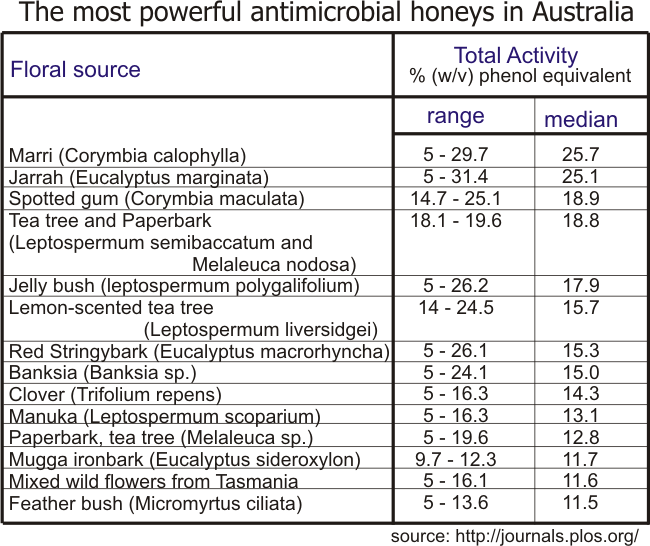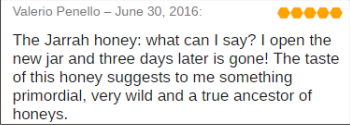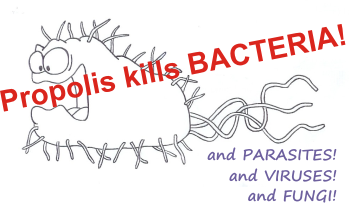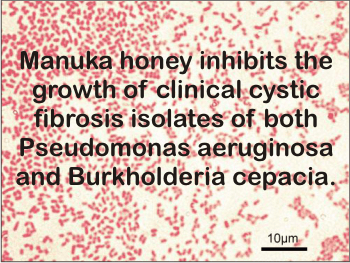Jarrah Honey comes from Western Australia, one of the best producers of honey in the world. And yes, when used fresh it kills candida better than manuka honey.
If people of New Zealand say manuka honey is the best honey in the world, Australians say it is Jarrah Honey. Not that they don’t have the famous manuka tree that provides the necessary nectar, but jarrah honey proved them to be even tastier and with some higher therapeutic properties. I know lots of Americans who agree with this.
Jarrah honey is a monofloral honey coming from the nectar of Jarrah tree’s flowers.
Jarrah tree
Native to southwest of Western Australia, Jarrah tree, on its botanical name Eucalyptus marginata, is one of the most common species of Eucalyptus tree.
The tree is huge and lives up to 1000 years. It grows up to 40 metres (130 ft) high with a trunk up to 3 metres (9.8 ft) in diameter, and has rough, greyish-brown, vertically grooved, fibrous bark which sheds in long flat strips.
The scientific name marginata refers to the light-colored vein on the border around its leaves.
The jarrah tree blooms every 2 or 3 years. The flowers come from stalked flower buds appear in clusters of between 7 and 11; each bud has a narrow, conical bud cap 5–9 millimetres (0.20–0.35 in) long. The flowers are white, 1–2 centimetres (0.39–0.79 in) in diameter, and bloom in spring and early summer. The nectar produced has a low moisture content.
The tree is important for its wood and honey it produces. The wood is heavy and appreciated for cabinet making, flooring, panelling and outdoor furniture, due to its long, straight trunks of richly coloured and beautifully grained termite-resistant timber. It has a deep rich reddish-brown color and an attractive grain. And it is also very valuable because it is very durable and water resistant, making it a choice structural material for bridges, wharves, railway sleepers, ship building and telegraph poles.
How is Jarrah honey?
Jarrah honey is produced in an area considered to be one of the last disease and pest free areas of the world, therefor it is recognized as 100% pure natural honey. Australian honey is relatively free of chemical residues, antibiotic residues and has low microbial counts.
Even more, it is known that only Western Australia protects its state forests and vigorously enforces strict quarantine controls for apiary products that are brought from overseas or interstate. This is why their hives are free from pests and diseases. No insecticides or pesticides are used.
Australia has a published organic honey standard and seven certification agencies. It requires locating hives at least 5 km from pesticide use and prohibits artificial antibiotics. There are many organically certified bee keeping operations. You can’t be more safer while eating honey from Australia.
Color: a medium to semi dark amber color
Consistency: thick
Flavor: rich and full-bodied flavor, smooth, delicate and slightly savory.
Taste: like caramel brown sugar, with some dried longan fruit aftertaste.
At a honey tasting consisting of 15 honeys – 12 Australian and 3 imported – Jarrah honey was placed on the first place, followed by mixed blossom, St Marys, mountain ash and orange blossom from Sicily.
– John Newton, the Sydney Morning Herald food critic, food writer and RAS judge, rated the taste of jarrah honey as the best in Australia. He said he loved its “thick treacle, malty rich flavor“.
– Janni Kyritsis, a leading light in Sydney’s food evolution during the past two decades while chef at Berowra Waters Inn, Bennelong and MG Garage, placed it on the second place, with “good viscosity“.
– Tim Pak Poy, one of Sydney’s finest chefs, owner of Claude’s in Woollahra, and co-owner of The Wharf at Walsh Bay, placed it on a forth place and found it had a “rich coffee nose“.
Glucose content: low
Fructose level: high
Glycemic Index: low. Jarrah honey is a preferred sweetener for diabetics. Fructose is absorbed more slowly and more evenly than glucose, making it perfect for endurance training and diabetics. Creators of the Hibernation Diet, Mike and Stuart McInnes, said that “foods with a high fructose content, such as a medicinal bioactive honey like Jarrah, help to burn fat while you sleep, and increase stamina as a result.”
Crystallization: very slow. It remains liquid for a very long time, due to its high fructose level.
Antioxidant level: very high.
· 2 to 3 times higher than in manuka honey or leatherwood honey (from Tasmania)
· almost the same as in buckwheat honey from the United States, considered to be the most powerful antioxidant honey in the world. (according to an independent research project undertaken by Dr Charles Dragar, Managing Director of Novost Pty Ltd)
read more on antioxidants in honey
Antimicrobial level: high. The antimicrobial quality is measured by the term of ‘Total Activity’ (TA) and it is given by its hydrogen peroxide activity. The higher the Total Activity (TA) the more active its antimicrobial strength.
According to the study The Antibacterial Activity of Honey Derived from Australian Flora by Julie Irish et al., published in 2011 by http://journals.plos.org/, the Total Antibacterial Activity (TA) of jarrah honey ranges from 5 to 31.4, with a median of 25.1. This places it on the first place of the most powerful antimicrobial honeys in Australia, just like marri honey, from Corymbia calophylla, which has a TA ranging from 5 to 29.7, with a median of 25.7.

All honeys have antimicrobial activity. It is given by:
· low pH (acidity)
· high osmotic effect
· hydrogen peroxide activity
· phytochemical components derived from the floral source confer additional antimicrobial activity, which is stable in the presence of catalase, an enzyme that destroys hydrogen peroxide (according to Molan 1992; Cooper et al., 2002; Al-Waili et al., 2011)
· certain substances (like MGO – methylglyoxal) contained by only some types of honeys, considered to give a non-hydrogen peroxide antimicrobial activity.
What is peroxide activity?
Hydrogen peroxide is a disinfectant used for decades in our medicinal world. Yet, it is unstable in the presence of air and light, which makes in difficult to store and use. In the process of making honey, bees add an enzyme called oxidase, which will break the glucose (present in the flower’s nectar) down into gluconic acid and hydrogen peroxide.
However, this doesn’t happen in pure honey, because of its low pH (it should be of at least 5.5) and low sodium quantity (it should be of at least 2,300 ppm, and not of 20 to 40 ppm, how it is found in honey).
But when honey is applied on a wound, burn or other skin infection, the serum from the tissues dilute the honey and raises its pH, also adding sodium and ultimately activating the enzyme oxidase. Thus, small quantities of hydrogen peroxide is produced little by little directly on the wound, making honey a perfect, slow-release antimicrobial product for treating wounds. It will kill bacteria, without harming the body tissue.
What is non-peroxide activity?
The non-peroxide activity was first identified in manuka (Leptospermum scoparium) honey from New Zealand where it is often marketed as the Unique Manuka Factor (UMF®). It is given by a toxic substance that kills microbes, called MGO (methylglyoxal), which is derived from dihydroxyacetone, a compound present in various levels in manuka nectar. The reasons for varying dihydroxyacetone levels in different plants are not yet understood.
Honeys with non-peroxide activity and their mean % (w/v) phenol equivalent:

Leptospermum species (17.9), Tasmanian wildflowers (12.7), Forest Red Gum (11.2), Melaleuca and brush box (10.5), Spotted gum (10.1), Clover (9.2), Orchard (9.1), Messmate stringybark (9.0).
Those the Leptospermum species have the highest concentration of non-peroxide activit, not all of them have it. Non-peroxide activity was identified in 70.6% of Australian Leptospermum honey samples tested, with a median of 16.7% phenol equivalent.
The highest concentration of non-peroxide activity was found in Leptospermum polygalifolium. Berriga honey derives from its nectar.
– Leptospermum polygalifolium – from Capricornia Queensland: 21.1 – has the highest concentration; in Northern Rivers New South Wales it has 18.9
– Leptospermum laevigatum from Northern Rivers New South Wales: 19.7
– Leptospermum liversidgei from Northern Rivers New South Wales: 16.1
– Leptospermum scoparium (the flower source of manuka honey!) had under 5, in all Australia.
– other Leptospermum spp also had under 5.
!Manuka honey from Australia does not have high concentration of MGO, if at all, it should not be confused with the one coming from New Zealand. Even if the plant is the same, the region, climatic condition, type and health of the honey bees, all make a big difference.
Is New Zealand manuka honey BETTER than Australian manuka honey?
Does Jarrah honey have non-peroxide activity?
Jarrah honey does not have MGO. Its antibacterial Total Activity is given by peroxide activity and the other antibacterial factors of honey (pH, sugars etc).
The advantages of non-peroxide activity vs peroxide activity:
• Peroxide activity is affected by light, temperature and age. It is also destroyed by catalase present in body fluids, and is some honeys.
• Non-peroxide activity is not destroyed by catalase present in body fluids, and is unaffected by gamma irradiation, allowing these honeys to be sterilized for medicinal use. It is not affected by light, temperature or age. On the contrary, in time non-peroxide activity increased in Leptospermum honeys.
Jarrah honey health benefits
• Treats any kind of skin infection, just like manuka honey from New Zealand. It makes an excellent choice for dressing golden staphylococcus infections and coli.
• It has antifungal effect. Honeys with high peroxide activity, like jarrah or marri, are very effective at inhibiting dermatophyte fungi and species of the yeast Candida (more effective than manuka honey). Studies showed its efficiency against Candida species, at a TA of 30.2% (w/v) phenol equivalent (MEDICAL MYCOLOGY 44,289-291., 2006)
• Very useful for diabetics. Jarrah honey has a high fructose sugar and low glucose level and its low glycemic index is suitable to be consumed by diabetics. Low glycemic foods are known to reduce insulin response in the body and improve the blood cholesterol level.
In Western Australia it is known as the world’s healing honey.
• It has anti-aging properties, due to its high content of antioxidants (2 or 3 times more than manuka honey from New Zealand). It supports active skin cell renewal, stimulates collagen and elastin production, proteins for wrinkle smoothing, collagen building and acne fighting. According to all new research, foods with high antioxidant levels fight free radicals that attack healthy T cells.
Take one spoonful in the morning, or as a honey and lemon drink – a delicious drink for your daily antioxidant boost.
• Relieves sore throat, due to the antimicrobial effect
• Relieves burns and sunburns while protecting the skin
• Clears mouth ulcers and bad breath – Jarrah honey helps combat stomach bacteria like Helicobacter pylori that may causes ulcers and bad breath.
“I have been eating Bees Neez Jarrah honey to treat helicobacter pylori, as the antibiotic treatment prescribed made me extremely ill and not altogether successful. I read about the medicinal quality of Jarrah honey, which to my delight has cleared the problem” Sonia, Perth West Australia.
Conclusion:
Eucalyptus marginata (jarrah) and Corymbia calophylla (marri) from Western Australia have exceptional hydrogen peroxide-dependent antibacterial activity. The level of activity varies widely among samples and decreases during storage.
Leptospermum species, particularly Leptospermum polygalifolium, growing in the coastal New South Wales-Queensland border region, have very high active non-peroxide antibaterial activity.
There are claims saying that: “New Zealand Manuka Honey is the only 100% natural food in the world shown to have effective and reliable antibacterial activity.” There are nevertheless differences between the two:
Honeys with hydrogen peroxide-dependent activity like jarrah honey are more effective than manuka honey at inhibiting dermatophyte fungi and species of the yeast Candida, indicating that these honeys may be more broad spectrum and valuable as antifungal agents than manuka honey.
There is not much jarrah honey in the world.
Here is why:
– It can be found only in Western Australia, not all over the world.
– It is produced from the Jarrah forest every second year if temperatures exceed 25˚C and there is adequate rainfall.
– There are diminishing forest reserves, unpredictable climate and wildfires.
– The request for it increases as the consumers are getting more and more aware of its qualities.
Yet, where can we find it?
 If you go to Western Australia you’ll find it in supermarkets or grocery stores. From the shelves of Woolworth’s & Coles supermarkets and select IGA stores.
If you go to Western Australia you’ll find it in supermarkets or grocery stores. From the shelves of Woolworth’s & Coles supermarkets and select IGA stores.
If you want it online, you can find it at some major producers like Ogilvy’s (the review is from their page), or Fewster’s Farm.
Or, you can order some from Amazon.com. Ogilvy’s honey can also be found on Amazon.co.uk.
Jarrah honey is becoming hugely popular in China!
Honey producer One Food Bee Farm has secured a 15-year agreement to supply honey to state-owned company China Merchants Food Co. One Food co-owners Rosie Liu said that “Manuka Honey had previously been highly popular in China because of its healing properties. But Jarrah honey was now considered “really special” and I believe that Jarrah honey will really quickly take over the position of Manuka honey in China.”
====================
References and picture credit:
flowers – picture credit Melanie Strang via ecoedge.com.au
https://en.wikipedia.org/wiki/Eucalyptus_marginata;
http://www.jarrahhoneyinfo.com/wp-content/uploads/2014/11/JarrahHoneyBrochure_11.2014.pdf;
http://www.abc.net.au/news/2015-12-30/jarrah-honey-export-china/7060772
http://www.farmweekly.com.au/news/agriculture/agribusiness/general-news/jarrah-honey-proves-sweet-source-of-antioxidants/2045343.aspx;
http://www.smh.com.au/articles/2003/09/23/1064082972297.html;
http://www.beesneez.com.au/types-of-honey.html





